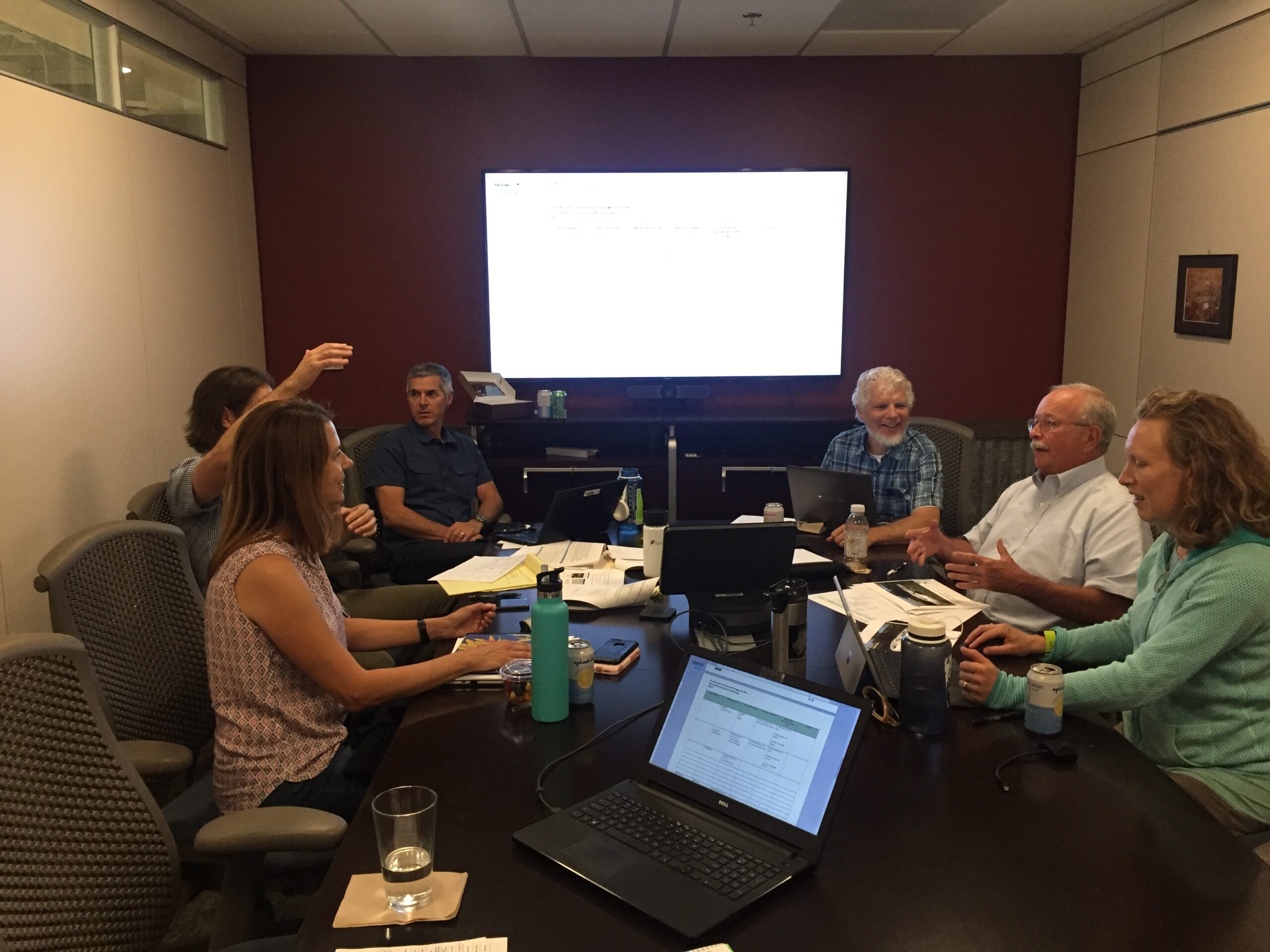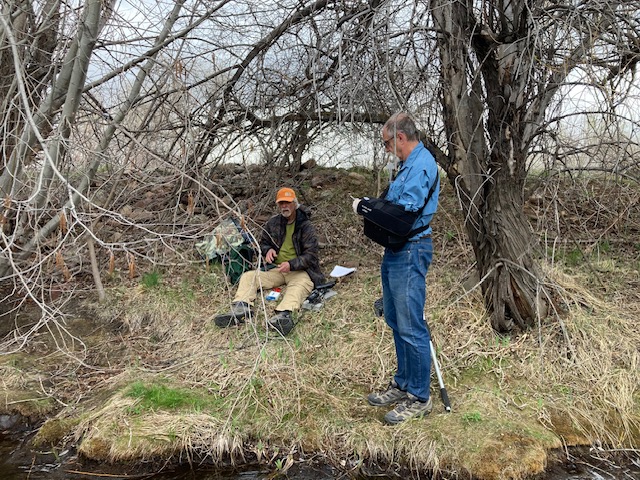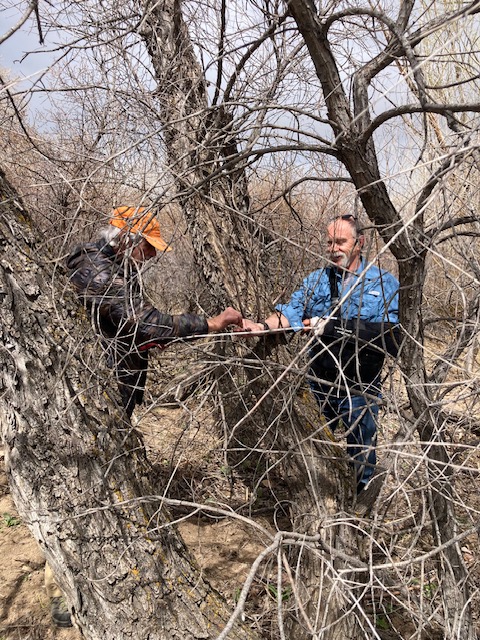South Boulder Creek Watershed Restoration Projects
What is Driving SBC Watershed Restoration Efforts?
Long-Term Drought and the Gross Reservoir Expansion creates challenges and likely changes to South Boulder Creek stream management
- Flow levels and patterns are changing – older diversion and associated infrastructure built based on different seasonal and overall assumptions about flows levels, timing, and annual water availability
- Gross Reservoir Expansion includes an Environmental Pool (EP) to provide vital, State administered, minimum in-stream flow rights
Ensuring the EP is Operational is a Critical Linchpin
- When the Gross Reservoir Expansion is complete and the reservoir re-filled, water managers must be able to administer and physically pass-through EP water from the dam to the confluence with Boulder Creek. This requires modifications to 8 diversion structures to work
- Keeping SBC wet in dry periods (especially non-irrigation) is critical to the long-term health of watershed, and to the water that flows through to users
- Through pooling resources across stakeholders there are opportunities to reconnect 10 of 12 miles of creek channel, create fish passage, and to rehabilitate habitat in the reach
BFC is Obtaining Funding, Organizing Project Teams, and Coordinating These Efforts
BFC is leading a coalition of water-rights owners, landowners, and other stakeholders to meet these challenges and goals
- Developed a comprehensive, State sponsored Stream Management Plan. This includes assessment of and recommendations for watershed restoration, as well as identifying multiple projects over the next 10 years.
- The most critical, time sensitive projects are to improve flow available from the EP. This requires modifying 8 diversion structures to pass and administer low flows. These efforts are currently in process, with the first construction project beginning in 2024
- BFC is the driving force to organize stakeholders and leverage resources to:
- Reconnect the channel and include fish passage in diversion modification project designs
- Include habitat, riparian and in-stream environmental improvements
To date, BFC has raised $2.7m for these projects, with another $300k from grant applications in process. Donors and partners include:
- State of Colorado
- US Fish & Wildlife Service
- City of Boulder
- City of Lafayette
- City of Louisville
- Boulder County
- Denver Water
- 14 ditch companies
- Colorado Trout Unlimited
- Boulder Flycasters
Update: May 2023
Download the WSR PH 1 Final Report
Download the SMP PH 1 Final Report
Download the SMP PH 2 Final Report
Update: November 2022
Beginning in 2017, Boulder Flycasters contacted key stakeholders to form a collaborative working group to address watershed improvement opportunities in lower SBC. The catalyst for bringing this group together was the (then) pending Gross Reservoir expansion project. The proposed (now approved) project included construction and implementation of an Environmental Pool (EP) within Gross Reservoir to provide for sustainable year-round, in-stream flows. The initial collaboration focused on how to prepare for the EP, and what flow management / infrastructure changes might be required. As the collaboration matured, the working group expanded discussions to include opportunities for channel connectivity, aquatic species passage, and habitat improvement to mitigate environmental degradation.
Stream Management Plan Project – To define and plan for infrastructure and environmental improvement, a Stream Management Plan (SMP – Phase I) project began in April 2019. In 2020, Phase I work was completed (coalition building, planning, data collection), and final reports submitted (June 2020). SMP Phase II was funded in August of 2020 and focused primarily on sub-reach level improvement opportunities based on field assessment of biology, hydrology, geo-morphology, and recreational needs and impacts. Phase II work was completed, and final reports submitted, in September 2022. This work was accomplished in close consultation with City of Boulder Open Space & Mountain Parks, the majority public land management agency along lower SBC.
Findings and Outcomes – In summary, the project team observed that the lower ~9 miles of SBC is a highly disturbed ecological system. The River Health Assessment (RHA) confirmed that environmental degradation from urban development, past mining, agriculture, water diversion activities, and flow regime management are all contributing to environmental degradation and low creek function. There are also 17 channel-spanning diversion structures in the 9-mile study reach. Eight (8) were identified as the primary sources of most flow management and channel connectivity / aquatic species passage issues, as well as stream function disruption. However, decreasing, and low, flow is the single most important factor contributing to deteriorating stream function and riparian conditions. Based on the assessment, the overall RHA Functional Score for lower SBC is 2.0 out of 4.0, described as “Partially Functioning.”
Recommendations include continuing to emphasize the operational planning, administrative tools, and water management infrastructure modifications necessary to successfully operate the EP, especially at very low flow levels, i.e., 1.5 to 10 cfs. And work toward other outcomes such as:
- Keeping more water in lower SBC for longer stretches through more efficient water delivery infrastructure, as well as potential water management and use, and associated operational changes
- Some of the non-flow assessment categories could potentially improve through alternative flow regime management techniques to better mimic natural stream flow conditions
- Stream bank and floodplain improvement will benefit the public and help Boulder OSMP maintain these lands
- Recommended riparian, geo-morphology, and aquatic habitat actions and future projects include:
- Education outreach regarding landscape and creek-side improvements with private landowners
- Moving recreation trails away from the creek bank, changes in grazing protocols, and alternative stock-water sources
- Increase streambank native plantings
- Use fencing to protect new plantings from people and cattle
- Enhance existing meanders and riffle / pool sequences, and stabilize eroding banks
- Incorporate channel connectivity / aquatic life passage into applicable ditch diversion structures to help reconnect the creek channel, allow for more natural migration patterns and improve overall creek function. (See WSR PH I final report)
- Define and implement an overall watershed database and associated analytics for lower SBC
Watershed Restoration Project – As a result of the SMP Phase I, recommendations for multiple ditch diversion structures’ modifications were identified. These recommendations were to help improve ditch operations, address environmental impacts, and meet the EP operational requirements. This work progressed to the point of justifying a separate project – Watershed Restoration Phase I (WSR PH I). WSR PH I (structure modification conceptual designs for channel connectivity, aquatic species passage, flow management, associated operational improvement, and proximate habitat / environmental improvements) launched in August 2020, and completed in September 2022.
The eight (8) high priority structures were each evaluated for alternatives to achieve the following:
- Ability to administer the Environmental Pool in-stream flows, allowing low flows to be released, measured, and controlled in accordance with the provisions of an inter-governmental agreement (IGA) between Cities of Boulder and Lafayette, and Denver Water
- Ability to pass aquatic organisms upstream and downstream past the diversion structure, considering native fish species, non-native sport fish, and macro-invertebrates
- Opportunities to mitigate existing maintenance and control issues with the diversion facilities
Three (3) diversion structures were identified as highest priority for modification due to the associated impact on overall stream function, and location in relation to other remediated structures. One (1) of these structures, the East Boulder Ditch Diversion Structure, was advanced to the final design stage in a cooperative effort of the City of Boulder and Xcel Energy. East Boulder Ditch is currently in the permitting phase to prepare for construction.
For the other two (2) highest priority structures, designs concepts were developed, and then advanced to a preliminary design level intended to represent approximately 15-20% of total design effort. These structures, New Dry Creek Carrier (NDCC) diversion and the Howard diversion, are near each other. Together they represent the largest disruptor of stream function in the 9-mile study reach. Additionally, low flow and aquatic species passage capable structures are upstream of these two, and the next downstream structure is in the process of modification for low flow / aquatic species passage (East Boulder Ditch). Together they block not only aquatic organism mobility but also limit transport of sediment and other materials that normally help shape the geomorphology of the creek channel. These two structures are now ready to progress to the final design stage.
Of the remaining five (5) structures, for three (3) – Davidson, Goodhue, Marshallville – conceptual designs were developed to ready these structures to progress to the preliminary design phase. For two (2) – FRCIO / Community, Leggett – notes, photos and simple drawings were developed to prepare these structures to progress to the conceptual design stage.
The next phase of funded projects will continue developing engineering designs for structures and coordinating with structure owners. Grants and matching funding were approved to take two (2) additional structures to the 100% design level (permit and construction phase ready). The New Dry Creek Carrier Ditch Diversion and the Howard Ditch Diversion are identified for these final designs. And a gate system automation project is also funded to be constructed at New dry Creek Carrier.
Across all projects, these organizations participated in this collaborative effort:
Stakeholders – City of Boulder, City of Lafayette, Denver Water, Boulder County, City of Louisville, 14 ditch ownership groups, and Xcel Energy
Advisors– Colorado Parks & Wildlife, Colorado Water Conservation Board, Division of Water Resources, and US Fish & Wildlife Service
Funding Sources – Colorado Water Conservation Board, US Fish & Wildlife Service, City of Boulder, City of Lafayette, Denver Water, and Trout Unlimited
Update: May 13, 2020
Boulder Flycasters and Colorado TU completed Phase I of the Lower South Boulder Creek Stream Management Plan (SMP) on April 30, 2020. The overall project scope included: Stakeholder Outreach, Data Collection / Assessment, River Health Assessment (RHA) Methodology Selection, and Existing Physical Infrastructure Assessment. The project commenced in March 2019, and all field work tasks were completed in November 2019. We completed Phase I on-time and under the $111,000 budget. The Phase I final report will be available as soon as the State review and approval
is finished. To summarize, the major recommendations for Phase II are:
- Execute the stakeholder communications plan developed in Phase I
- Close remaining data gaps identified in Phase I, and continue / add to water quality and
quantity data collection (monitoring) efforts - Refine the RHA methodology, and conduct the assessment of this reach against the biological,
hydrological, geomorphological and recreational categories defined - Complete point flow analysis for the project reach, develop the “highest practical” flow scenario
and assess flow parameters as part of the RHA - Conduct preliminary engineering designs for the seven (7) highest priority structures, with low
flow capabilities, aquatic organism passage, habitat improvement and structure efficiency as
criteria
As a result, Phase II is largely focused on conducting the physical assessment of the reach for overall
flow, habitat, water, and use improvement opportunities that will be defined at a level of detail to be
build / execution ready. Funding for Phase II ($321,000) is secured through State and Federal grants,
and matching funds. We are in the process of finalizing contracts with State and Federal agencies.
We expect to kick off Phase Ii in June 2020. The project will then run until the end of 2021.
Update, 16 January 2019
The Lower South Boulder Creek, Stream Management Plan Project is a Go!
Status:
We received approval from the Colorado Water Conservation Board (CWCB) this week for the underling grant. The CWCB grant represents 50% of the funding needs. And cash-matching funds were approved last week by the Metro Basin Round Table (12.5%), and South Platte Basin Round Table (12.5%). Previous commitments of cash matching funds came from Colorado TU (5%), and Boulder Flycasters (6%). We still need to raise $6,000 to close the cash needs gap.
In-kind matching funds approved include staff or volunteer work hours, and / or equipment, from Boulder Water (BW), Lafayette Water (LW), Denver Water (DW), Boulder Open Space & Mountain Parks (BOSMP), Colorado TU and Boulder Flycasters. In-kind matching fund commitments currently exceed our estimated needs, so we have some contingency labor hours available.
Once the contract documents are negotiated with the funding sources, we expect to perform project start up tasks in February, and the core of the project work to start up in March. We are about to circulate an RFP to selected firms to fill the role of Project Manager / Watershed Improvement Consultant. Then we will follow with an RFP for the Engineering Consultant role.
Background:
We are currently in the grant application cycle with the CWCB and other sources to fund a Stream Management Plan (SMP) for lower South Boulder Creek. This is the ~9 mile stretch that starts at the mouth of Eldorado Canyon (east entrance to Eldorado State Park and just upstream of the town of Eldorado Springs) and terminates at the confluence with Boulder Creek. Lower South Boulder Creek is a highly engineered stretch with at least 20 head gates and associate diversion structures, resulting in a relatively complex water rights management and flow management regimens. The stretch flows through environmentally sensitive areas and also through high use Open Space in Boulder County (owned and managed by the City of Boulder). The amount of water diversion above and on this stretch results in no-to-low, in-stream flows during much of the winter months (non-irrigation season). We are working with BW, LW, DW and BOSMP on a project to increase year round in-stream flows and associated habitat improvement on this stretch. This is largely being driven by the Gross Reservation Expansion Project (“Moffat Firming Project”). When DW receives final permitting to construct the expansion, there will be an associated Environmental Pool constructed to house 5,000 AF of water for in-stream flow purposes, with water provided by Boulder and Lafayette.
The Project:
To help prepare for the implementation and execution of the Environmental Pool, and to maximize the opportunity this watershed improvement opportunity presents, we started working informally with the core stakeholders (DW, BW, LW, BOSMP) in the fall of 2017. We are now at a point where having a “master plan” for these efforts is needed. CWCB is tasked with implementing the Colorado Water Plan. Part of that is to fund watershed improvement projects across the State that align with the Water Plan goals. One type of grant is for a Stream Management Plan (SMP). We are applying for a reduced scope SMP (“Phase I”).
The major tasks are:
- Formalize and expand our stakeholder group
- Gain agreement on River Health Assessment methodology (biological, hydrological, and geo-morphological)
- Collect, categorize and assess existing watershed data (scientific, engineering and other studies) to establish a baseline of work already completed
- Gain agreement on Physical Infrastructure Assessment Methodology, and complete high level, conceptual designs for likely modifications needed to shepherd low flows through the stretch
- Identify opportunities for habitat and infrastructure improvement, including fish passage, as well as opportunities for more efficient water use
Most of the needed volunteer time will be spent working with our project manager on stakeholder outreach, gathering and cataloging the existing data, helping with the scientific and engineering field tasks, and identifying Phase II implementation projects.
Update, February, 2018
Boulder Flycasters Launches South Boulder Creek Flow and Water Quality Initiatives
In October 2017 Boulder Flycasters (BFC), in cooperation with Colorado Trout Unlimited (CTU), launched an effort to address South Boulder Creek (SBC) in-stream, year-round flows and water quality improvements. The likely approval of the Gross Reservoir Expansion project within the next 12 to 18 months means that there will be renewed attention to this watershed. To gain permitting approvals, Denver Water, the owner of Gross Reservoir, committed to a number of watershed improvements and associated environmental monitoring. Additionally, the cities of Boulder and Lafayette, in cooperation with Denver Water, are also committed to improving in-stream, year-round water flows.
BFC’s efforts are being led by Rob McCormack, BFC president, and Stephen Brant, new board member and coordinator for these efforts. Many other BFC members have pitched in to help establish our objective and goals, provide background information, and to advise on technical issues. We also began discussions with Boulder’s and Lafayette’s water utilities, and Boulder Open Space and Mountain Parks, all with water rights, land and other stakes in improvements to SBC. CTU is also providing support and has the main contacts with Denver Water for when the time is right for working groups to meet.
As of this date, our goals and objectives are as follows:
GOAL: Build the needed collaborations, processes and organization to provide continuous improvement of water quality within the SBC watershed.
Objective 1: Develop a working collaboration between key stakeholders (city water utilities, ditch owners, the public) committed to improving year round, in-stream flows and water quality.
Objective 2: Facilitate the operation of an Environmental Pool within Gross Reservoir to provide sustainable, in-stream water flows year-round, as provided for in an Inter-Governmental Agreement (IGA) between Denver Water, Boulder Water and Lafayette Water. This includes a proposal to facilitate the operation of an interim Environmental Pool until the Gross Reservoir expansion is complete.
Objective 3: Help implement and support monitoring along SBC to build a database of key water quality measures. This is the most important near-term objective to get into place. To our knowledge there is no current comprehensive database of SBC water quality measures. Getting this started as soon as possible will help to build a baseline for monitoring and measurement. This database can then be used to make adjustments to water quality processes, measuring flows, and defining improvement and mitigation requirements.
Although still in the early stages of working through the issues and timelines to accomplish these goals, we are excited about the willingness of our working partners to achieve these ends. If you would like further information or to volunteer your help, please contact Stephen or Brendan via email.






